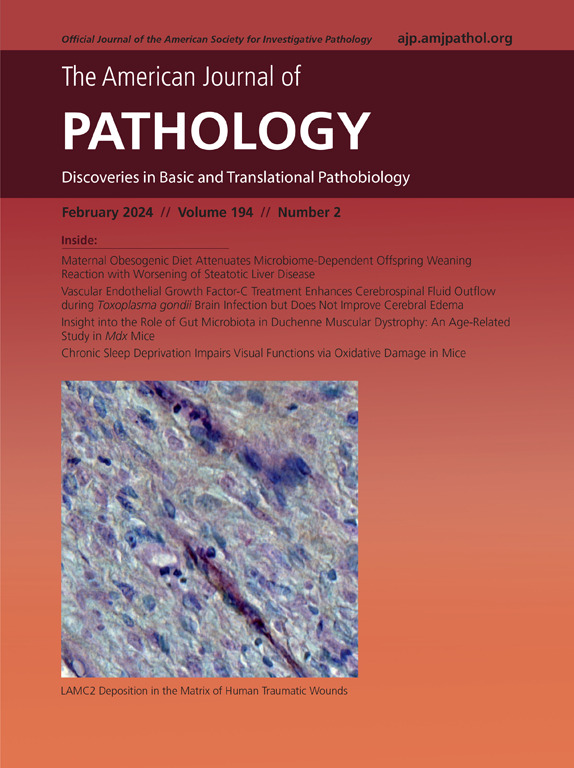人类 MUC2 粘蛋白产生的结肠鹅膏样细胞通过激活多种促炎途径分泌趋化因子 CXCL8,以应对组织溶解性肠虫。
IF 3.6
2区 医学
Q1 PATHOLOGY
引用次数: 0
摘要
高度应激的杯状细胞产生的黏液层在肠道内形成保护屏障,保护底层粘膜上皮细胞免受外部威胁。杯状细胞MUC2粘蛋白的高分泌和耗竭是有症状的溶组织内阿米巴感染的特征。我们假设MUC2缺失的杯状细胞可以通过产生促炎细胞因子来建立先天宿主防御的第二道防线。为了研究这一点,我们确定Eh是否可以刺激野生型(WT)高MUC2黏液蛋白产生的杯状细胞和CRISPR-Cas9基因编辑的MUC2KO细胞的促炎反应。对于活的Eh和可溶性的Eh蛋白,WT和MUC2KO细胞产生高水平的CXCL8。与MUC2KO细胞相比,Eh在WT细胞中暂时诱导更高水平的CXCL8 mRNA表达和蛋白分泌,这一现象随着nadph氧化酶抑制剂二苯二氯铵(DPI)减轻内质酰胺应激而被消除。WT细胞产生升高的ROS,诱导CXCL8转录物的半衰期延长,DPI消除了这一半衰期。Western blotting和蛋白质组学分析显示,WT细胞(而非MUC2KO细胞)通过快速激活MAPK/ERK、MAPK/p38和PI3K/Akt通路来诱导CXCL8,从而基本启动对外部应激源的反应,并对Eh做出反应。这些结果表明,结肠杯状细胞通过分泌高粘液来防御Eh感染,并产生趋化因子CXCL8来招募中性粒细胞。本文章由计算机程序翻译,如有差异,请以英文原文为准。

Human Mucin-2–Producing Colonic Goblet-Like Cells Secrete the Chemokine CXCL8 by Activating Multiple Proinflammatory Pathways in Response to Entamoeba histolytica
The mucus layer produced by highly stressed goblet cells forms a protective shield in the gut to protect the underlying mucosal epithelial cells from external threats. Hypersecretion and depletion of mucin-2 (MUC2) mucin from goblet cells is characteristic of symptomatic Entamoeba histolytica infections. It was hypothesized that MUC2 depleted goblet cells could mount a second line of innate host defense by producing proinflammatory cytokines. To investigate this, whether E. histolytica could stimulate proinflammatory responses in wild-type (WT) high MUC2 mucin-producing goblet-like cells and in clustered regularly interspaced palindromic repeats and CRISPR-associated protein 9 (CRISPR-Cas9) gene-edited MUC2KO cells was investigated. In response to live E. histolytica and soluble E. histolytica proteins, WT, and to a lesser extent, MUC2KO cells produced high levels of CXCL8. Entamoeba histolytica temporally induced greater levels of CXCL8 mRNA expression and protein secretion in WT versus MUC2KO cells, which was abrogated with alleviation of endoplasmic reticulum stress with the NADPH-oxidase inhibitor diphenyleneiodonium chloride. WT cells produced elevated reactive oxygen species that induced longer half-lives of CXCL8 transcripts, which was abrogated with diphenyleneiodonium chloride. Western blot and proteomic analyses revealed that WT cells, but not MUC2KO cells, were basally primed to respond to external stressors and responded to E. histolytica through rapid activation of the mitogen-activated protein kinase/extracellular signal-regulated kinase, mitogen-activated protein kinase/p38, and phosphatidylinositol 3-kinase/Akt pathways, to induce CXCL8. These results suggest that colonic goblet-like cells defend against E. histolytica infections by hypersecreting mucus and produce the chemokine, CXCL8, to recruit neutrophils.
求助全文
通过发布文献求助,成功后即可免费获取论文全文。
去求助
来源期刊
CiteScore
11.40
自引率
0.00%
发文量
178
审稿时长
30 days
期刊介绍:
The American Journal of Pathology, official journal of the American Society for Investigative Pathology, published by Elsevier, Inc., seeks high-quality original research reports, reviews, and commentaries related to the molecular and cellular basis of disease. The editors will consider basic, translational, and clinical investigations that directly address mechanisms of pathogenesis or provide a foundation for future mechanistic inquiries. Examples of such foundational investigations include data mining, identification of biomarkers, molecular pathology, and discovery research. Foundational studies that incorporate deep learning and artificial intelligence are also welcome. High priority is given to studies of human disease and relevant experimental models using molecular, cellular, and organismal approaches.

 求助内容:
求助内容: 应助结果提醒方式:
应助结果提醒方式:


